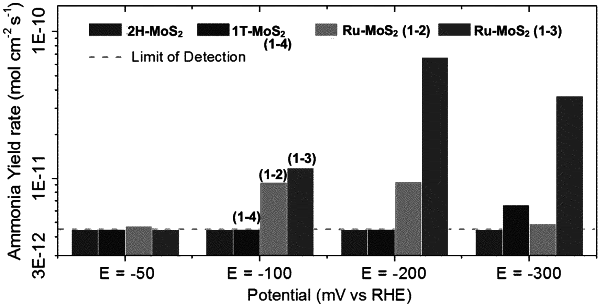| CPC C25B 11/054 (2021.01) [C25B 1/27 (2021.01); C25B 11/057 (2021.01); C25B 11/067 (2021.01); C25B 11/081 (2021.01); C25B 15/08 (2013.01)] | 20 Claims |

|
1. A method of reducing dinitrogen to ammonia, the method comprising:
contacting an electrocatalytic composition with dinitrogen and an electrolyte comprising a source of hydrogen; and
applying a potential at the electrocatalytic composition sufficient to reduce the dinitrogen and the source of hydrogen on the electrocatalytic composition to form ammonia,
wherein the electrocatalytic composition comprises:
a support material present in one or more crystalline phases; and
metallic clusters dispersed on the support material, the metallic clusters comprising at least one metal selected from ruthenium, iron, rhodium, iridium and molybdenum,
wherein at least 80 mass % of the support material is present in a semiconductive crystalline phase having a conduction band minimum energy below (more positive than) −0.3 V relative to the normal hydrogen electrode (NHE),
wherein the semiconductive crystalline phase is a 2D-crystalline phase and wherein the metallic clusters are at least partially intercalated between layers of the 2D-crystalline phase.
|